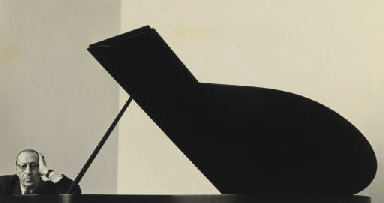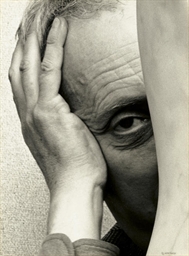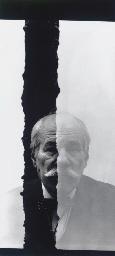THE ARC OF PHOTOGRAPHY: A PRIVATE EAST COAST COLLECTION Arnold Newman I.M. Pei 1967 Gelatin silver print. 13 1/8 x 10 5/8 in. (33.3 x 27 cm). Signed, titled, dated and copyright in pencil in the margin; copyright credit reproduction limitation stamp on the verso.
Provenance Deborah Bell Photographs, New York Literature Diamonstein, Vision and Images: American Photographers on Photography, p. 147; LIGHT Gallery, LIGHT, p. 68; Little Brown & Company, Arnold Newman’s Americans, pl. 52; New York Graphic Society, One Mind’s Eye: The Portraits and Other Photographs of Arnold Newman p. 185 Catalogue Essay The Performance of Identity The Arc of Photography: A Private East Coast is consistently buttressed by outstanding works depicting touchstones in the field of Photography over 150 years, especially in the genre of identity and performance. Indeed, the strength of the collection lies in its breadth, providing a cohesive, chronological narrative addressing the various permutations the field has undergone while consistently addressing the topic of self-presentation throughout, be it that of the photographer or the sitter. Amassed over a period of X years, the collection reflects a keen observational eye, supported by a strong scholastic acumen, which has meticulously secured the foundations that have provided inspiration for countless photographers on both sides of the Atlantic. Upon careful inspection, the dialogue between classic and contemporary photographers in the presentation of identity and its performative underpinnings becomes more evident. The rare, satirical portrait of the beloved clown figure, Pierrot, by the French fraternal duo Nadar and Adrien Tournachon in the mid 1850s is an exceptional remnant of the prevailing popularity of satirical portraits, in all of their exaggerated poses, favored by the French literati at that era. The heavy-handed expressiveness of the work resonates with Edward Weston’s Tina with Tear, taken almost 70 years later, in its facile emotional legibility. Similarly, Nic Aluf’s portrait of Sophie Taeubur-Arp, 1920, which captures the Dadaist interest in the seemingly random assemblage of symbols in which the famed Swiss artist engages, bears a strong parallel to Irving Penn’ postrait of the famed cartoonist for The New Yorker, Saul Steinberg in which he is reduced to a vaguely absurdist sketch that readily identifies Steinberg’s comical style. And Gertrude Käsebier’s portrait of Auguste Rodin 1905, somber and deeply meditative, is careful in highlighting the famed sculptor’s majestic presence and heavy hands, just as Gerard Richter’s portrait of the famed collaborative Brit couple, Gilbert & George, 1975, captures their interchangeable personalities and strong dynamism. Additional examples also abound in self-portraiture, where the photographers carefully cull an aspect within that they feel strongly denotes the performative role of the photographer in creating an image and presenting a self. André Kertész’s self-portrait from 1926, taken a mere year after the progressive Hungarian artist made the leap to the center of the avant-garde, Paris, presents the artist as a modern sophisticate amidst a Modigliani-inspired setting that aligned him with one of the leading artists of his day. The self-conscious undertone of the work resonates with Andy Warhol’s Self Portrait in Drag, created almost half a century later, which likewise employs a playful undertone, rife in humor and alignment with an alternate personality to comment on social roles and selfhood. Similarly, Man Ray’s self-portrait, 1933, is comprised of disparate elements, fragments of his Surrealist imagination that derive their strength and narrative from their convergence within the image. This is redolent of Bruce Nauman’s own presentation of 5 images, in each of which the artist alters his mouth and skin, which collectively attest to Nauman’s innovative, corporeal engagements. And Edgar Degas’ 1895 reverential and noble self-portrait as a dignified savant within the confines of his library is as controlled and deliberate as Cindy Sherman’s Untitled # 382/The Actress, 1976-2000, in which she successfully staged her own self-presentation to assume a role that highlights the theatrical nature in s
THE ARC OF PHOTOGRAPHY: A PRIVATE EAST COAST COLLECTION Arnold Newman I.M. Pei 1967 Gelatin silver print. 13 1/8 x 10 5/8 in. (33.3 x 27 cm). Signed, titled, dated and copyright in pencil in the margin; copyright credit reproduction limitation stamp on the verso.
Provenance Deborah Bell Photographs, New York Literature Diamonstein, Vision and Images: American Photographers on Photography, p. 147; LIGHT Gallery, LIGHT, p. 68; Little Brown & Company, Arnold Newman’s Americans, pl. 52; New York Graphic Society, One Mind’s Eye: The Portraits and Other Photographs of Arnold Newman p. 185 Catalogue Essay The Performance of Identity The Arc of Photography: A Private East Coast is consistently buttressed by outstanding works depicting touchstones in the field of Photography over 150 years, especially in the genre of identity and performance. Indeed, the strength of the collection lies in its breadth, providing a cohesive, chronological narrative addressing the various permutations the field has undergone while consistently addressing the topic of self-presentation throughout, be it that of the photographer or the sitter. Amassed over a period of X years, the collection reflects a keen observational eye, supported by a strong scholastic acumen, which has meticulously secured the foundations that have provided inspiration for countless photographers on both sides of the Atlantic. Upon careful inspection, the dialogue between classic and contemporary photographers in the presentation of identity and its performative underpinnings becomes more evident. The rare, satirical portrait of the beloved clown figure, Pierrot, by the French fraternal duo Nadar and Adrien Tournachon in the mid 1850s is an exceptional remnant of the prevailing popularity of satirical portraits, in all of their exaggerated poses, favored by the French literati at that era. The heavy-handed expressiveness of the work resonates with Edward Weston’s Tina with Tear, taken almost 70 years later, in its facile emotional legibility. Similarly, Nic Aluf’s portrait of Sophie Taeubur-Arp, 1920, which captures the Dadaist interest in the seemingly random assemblage of symbols in which the famed Swiss artist engages, bears a strong parallel to Irving Penn’ postrait of the famed cartoonist for The New Yorker, Saul Steinberg in which he is reduced to a vaguely absurdist sketch that readily identifies Steinberg’s comical style. And Gertrude Käsebier’s portrait of Auguste Rodin 1905, somber and deeply meditative, is careful in highlighting the famed sculptor’s majestic presence and heavy hands, just as Gerard Richter’s portrait of the famed collaborative Brit couple, Gilbert & George, 1975, captures their interchangeable personalities and strong dynamism. Additional examples also abound in self-portraiture, where the photographers carefully cull an aspect within that they feel strongly denotes the performative role of the photographer in creating an image and presenting a self. André Kertész’s self-portrait from 1926, taken a mere year after the progressive Hungarian artist made the leap to the center of the avant-garde, Paris, presents the artist as a modern sophisticate amidst a Modigliani-inspired setting that aligned him with one of the leading artists of his day. The self-conscious undertone of the work resonates with Andy Warhol’s Self Portrait in Drag, created almost half a century later, which likewise employs a playful undertone, rife in humor and alignment with an alternate personality to comment on social roles and selfhood. Similarly, Man Ray’s self-portrait, 1933, is comprised of disparate elements, fragments of his Surrealist imagination that derive their strength and narrative from their convergence within the image. This is redolent of Bruce Nauman’s own presentation of 5 images, in each of which the artist alters his mouth and skin, which collectively attest to Nauman’s innovative, corporeal engagements. And Edgar Degas’ 1895 reverential and noble self-portrait as a dignified savant within the confines of his library is as controlled and deliberate as Cindy Sherman’s Untitled # 382/The Actress, 1976-2000, in which she successfully staged her own self-presentation to assume a role that highlights the theatrical nature in s








/909/1179909.jpg)






Try LotSearch and its premium features for 7 days - without any costs!
Be notified automatically about new items in upcoming auctions.
Create an alert